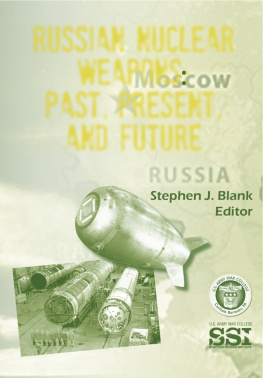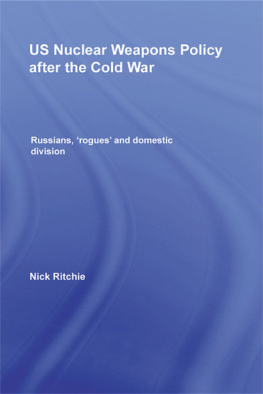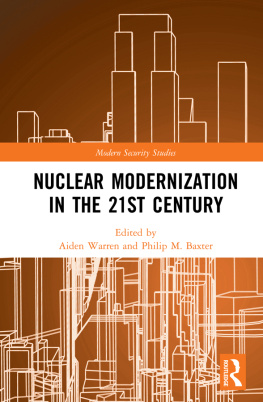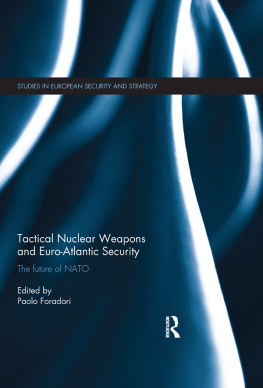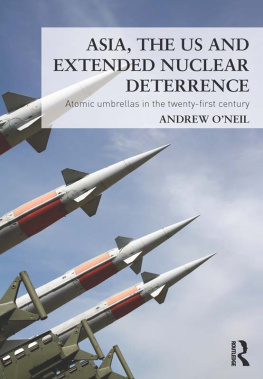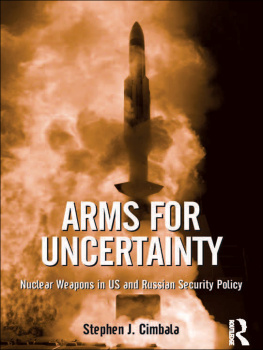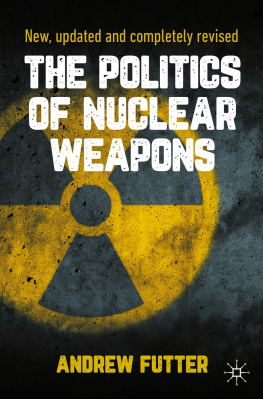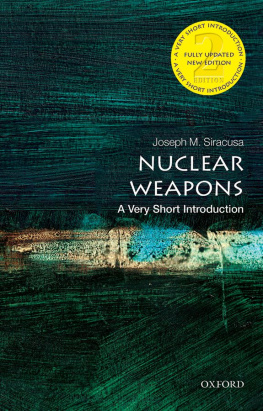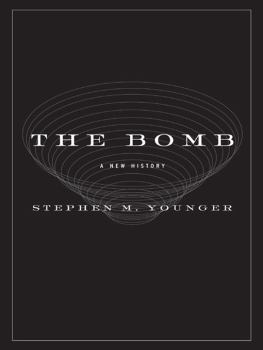Strategic Studies Institute Book
RUSSIAN NUCLEAR WEAPONS:
PAST, PRESENT, AND FUTURE
Stephen J. Blank
Editor
November 2011
The views expressed in this report are those of the authors and do not necessarily reflect the official policy or position of the Department of the Army, the Department of Defense, or the U.S. Government. Authors of Strategic Studies Institute (SSI) publications enjoy full academic freedom, provided they do not disclose classified information, jeopardize operations security, or misrepresent official U.S. policy. Such academic freedom empowers them to offer new and sometimes controversial perspectives in the interest of furthering debate on key issues. This report is cleared for public release; distribution is unlimited.
*****
This publication is subject to Title 17, United States Code, Sections 101 and 105. It is in the public domain and may not be copyrighted.
*****
Comments pertaining to this report are invited and should be forwarded to: Director, Strategic Studies Institute, U.S. Army War College, 632 Wright Ave, Carlisle, PA 17013-5046.
*****
All Strategic Studies Institute (SSI) publications may be downloaded free of charge from the SSI website. Hard copies of this report may also be obtained free of charge while supplies last by placing an order on the SSI website. The SSI website address is: www.StrategicStudiesInstitute.army.mil .
*****
The Strategic Studies Institute publishes a monthly e-mail newsletter to update the national security community on the research of our analysts, recent and forthcoming publications, and upcoming conferences sponsored by the Institute. Each newsletter also provides a strategic commentary by one of our research analysts. If you are interested in receiving this newsletter, please subscribe on the SSI website at www.StrategicStudiesInstitute.army.mil / newsletter/.
ISBN 1-58487-504-6
CONTENTS
Foreword ........................................................................v
Introduction .................................................................vii
Stephen J. Blank
Part I
1. Russian Nuclear and Conventional Weapons:
The Broken Relationship .........................................1
Dale R. Herspring
2. Russias Conventional Armed Forces:
Reform and Nuclear Posture to 2020 ...33
Roger N. McDermott
Part II
3. Nuclear Weapons in Russian Strategy and
Doctrine ................................99
Andrei Shoumikhin
4. Russias Security Relations with the
United States: Futures Planned and
Unplanned..............................................................161
Pavel K. Baev
5. Nuclear Weapons in Russian National
Security Strategy .......................187
Nikolai Sokov
Part III
6. Caught between Scylla and Charybdis: The
Relationship between Conventional and
Nuclear Capabilities in Russian Military
Thought ...........................................................261
Daniel Goure
7. Russia and Nuclear Weapons..............................293
Stephen J. Blank
8. Russian Tactical Nuclear Weapons: Current
Policies and Future Trends..................................365
Richard Weitz
9. New Start and Nonproliferation: Suitors or
Separate Tables?....................................................417
Stephen J. Cimbala
10. Russias Nuclear Posture and the Threat
that Dare Not Speak its Name............................459
Jacob W. Kipp
About the Contributors ............................................505
FOREWORD
While the Cold War is long past, the importance of arms control in Russo-American relations and the related issue of nuclear weapons for Russia remain vital concerns. Indeed, without an appreciation of the multiple dimensions of the latter, progress in the former domain is inconceivable. With this in mind, the Strategic Studies Institute (SSI) is very pleased to present the following essays, which were presented at a conference at the National Defense University on June 28, 2010. These essays explore many, if not all, of the issues connected with Russias relatively greater reliance on nuclear weapons for its security. As such, they constitute an important contribution to the analysis of the Obama administrations reset policy, Russo-American relations, Russian foreign and defense policy, and international security in both Europe and Asia. Additionally, questions concerning the approach taken by other nuclear power nations in reference to the arms control agenda provide a crucial backdrop for the progress toward curbing the proliferation of nuclear weapons, a long-standing central goal of U.S. security policy.
We offer these essays to our readers in the belief that the information and analyses contained herein will strengthen our understanding of Russias extensive nuclear agenda and provide a deeper understanding of the many issues in international security connected with Russia and its nuclear posture.

INTRODUCTION
As of November 2010, the so-called New START (Strategic Arms Reduction Treaty) treaty between the United States and Russia that was signed in Prague, Czech Republic, on April 8, 2010, awaits a ratification vote in the Senate. Regardless of the arguments pro and con that have emerged since it was signed, it is clear that the outcome of the ratification vote will not only materially affect the Obama administrations reset policy towards Russia, but also the strategic nuclear forces of both signatories. Indeed, throughout the Cold War, both sides built up their forces based on what each was thought to have or be building. Although the Bush administration (2001-09) rhetorically announced its intention to sever this mutual hostage relationship, it failed in that regard. As a result, critical aspects of that relationship still survive in Russias orientation to the United States and in the language of the treaty, especially in its preamble, which explicitly affirms a link between nuclear offense and defense.
Therefore, whatever the fate of the treaty and the reset policy, it is clear that both Moscow and Washington stand before crossroads in regard to the future of their strategic nuclear programs and force structures. Moreover, each sides course of action will tangibly affect the future course of action of the other side regarding the panoply of issues and policies connected with the development of nuclear weapons and the missions for them. With this in mind, the Office of the Secretary of Defense (OSD) organized a conference bringing together several distinguished experts on Russian nuclear weapons. The conference took place at the National Defense University, Fort Lesley J. McNair, Washington, DC, on June 28, 2010, and the papers that follow are the revised versions of the papers presented at this conference.
Each author was asked to answer several different questions pertaining to the present and future posture of Russias nuclear weapons (including tactical nuclear weapons). Moreover, it quickly became clear that Russias nuclear future in many ways, large and small, depends greatly on the degree of success that Moscow will have in its current large-scale efforts at comprehensive military reform. These reforms encompass virtually the entire military structure and are the most thoroughgoing reforms since Mikhail Frunzes reforms in 1924-25. Consequently, no analysis of nuclear present and future posture is possible without a systematic analysis of those reforms and their impact. Therefore, the following chapters provide an examination of Russias military and political motives behind nuclear weapons policy as they pertain not only to the U.S./North Atlantic Treaty Organization (NATO), but also to China, whose rising power has clearly caught the Kremlins attention.

